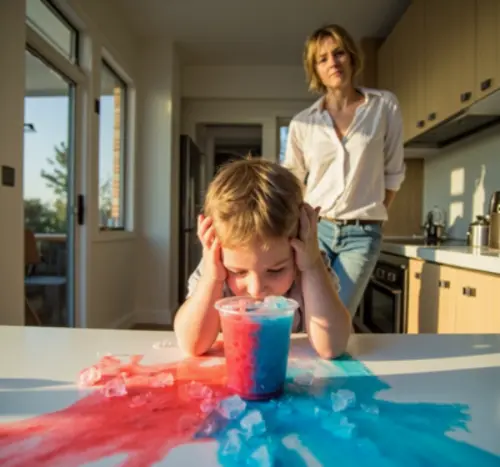- Is Slushy Harmful? Health Risks Behind the Frozen Treat
- Why Is Glycerol Used in Slushies and Is Slushy Harmful?
- Is Slushy Harmful Due to Glycerol Intoxication?
- How Much Is Too Much? Understanding If Slushy Is Harmful
- Who Is Most at Risk and Why Is Slushy Harmful for Them?
- Why Parents Should Be Concerned About Whether Slushy Is Harmful
- Are There Long-Term Effects?
- What Should Be Done?
- Safer Alternatives to Slush Drinks
Is Slushy Harmful? Health Risks Behind the Frozen Treat
Slushy drinks—those colorful, icy beverages that are especially popular among children—may appear harmless at first glance. However, recent scientific evidence raises a critical question: Is slushy harmful? Research from the UK and Ireland has shed light on a growing concern involving one key ingredient used in slushies: glycerol.
Why Is Glycerol Used in Slushies and Is Slushy Harmful?
Glycerol (also known as glycerine or E422) is added to slushy drinks to maintain their signature semi-frozen texture. It replaces sugar in many formulations, making the drink more appealing to health-conscious parents. However, this very substitution is what introduces a hidden risk for young children.
Is Slushy Harmful Due to Glycerol Intoxication?
What Is Glycerol Intoxication?
Recent studies documented a phenomenon known as glycerol intoxication syndrome. This condition occurs when high levels of glycerol are rapidly consumed, usually through slushy drinks. The syndrome mimics symptoms of metabolic diseases and can cause:
- Loss of consciousness
- Hypoglycaemia (low blood sugar)
- Metabolic (lactic) acidosis
- Pseudohypertriglyceridaemia (false high fat levels)
- Hypokalaemia (low potassium)
Case Studies and Evidence
A study published in Archives of Disease in Childhood examined 21 children aged between 2 and 7 who required emergency care after consuming slush drinks. All of them exhibited severe symptoms within an hour of consumption. In some cases, children were hospitalized with seizures, hallucinations, and near-fatal outcomes.
How Much Is Too Much? Understanding If Slushy Is Harmful
According to the EFSA (European Food Safety Authority), glycerol itself has low toxicity under normal food additive conditions. However, if consumed quickly and in large quantities—especially by small children—even a single slushy drink can exceed the threshold known to cause side effects like nausea, dizziness, and unconsciousness.
For example, one can of flavored drink (330 mL) may contain enough glycerol to cross the 125 mg/kg body weight per hour limit in toddlers.
Who Is Most at Risk and Why Is Slushy Harmful for Them?
Children under 8 years old, and especially those under 4, are most vulnerable. Their smaller body size makes them more susceptible to the effects of glycerol. The Food Standards Agency (FSA) and Food Standards Scotland (FSS) now recommend:
- Children under 4: should not consume slushy drinks with glycerol
- Children 5 to 10: should consume them with caution, and avoid multiple servings or free refills
Why Parents Should Be Concerned About Whether Slushy Is Harmful
Most parents are unaware that a seemingly innocent treat can lead to a medical emergency. Labeling regulations often do not clearly indicate the glycerol content, and warnings are inconsistently applied at points of sale.
Symptoms to Watch For After Slushy Consumption
If your child consumes a slushy and shows the following symptoms within 60 minutes, seek medical attention immediately:
- Sudden drowsiness or unresponsiveness
- Vomiting or nausea
- Dizziness or seizures
- Unusual sweating or shivering
Are There Long-Term Effects?
There is no evidence of long-term harm if the child recovers quickly and does not reconsume the product. However, repeated exposure may increase the risk of recurrent hypoglycemia and electrolyte imbalance, particularly in children with undiagnosed metabolic sensitivities.
What Should Be Done?
Recommendations for Parents
- Check labels for glycerol, glycerine, or E422
- Avoid giving slushies to children under 8, especially under 4
- Don’t allow free refills for children in restaurants or entertainment centers
- Watch portion size and speed of consumption
Calls for Policy Change
Health experts urge public health authorities to:
- Enforce mandatory age-based labeling
- Limit the allowable glycerol concentration in slush drinks
- Educate parents about potential risks through public campaigns
Safer Alternatives to Slush Drinks
If your child enjoys frozen treats, consider these alternatives:
- 100% fruit smoothies made at home
- Ice pops with natural fruit juices
- Frozen yogurt with minimal added sweeteners
These options eliminate the risks associated with glycerol and provide more nutritional value.
Conclusion
So, is slushy harmful? For healthy adults, an occasional slush drink might pose no issue. But for children—especially those under eight—the answer is yes. The high glycerol content can cause serious health complications in a short time. The colorful, frozen allure of slushies hides a complex chemical risk that parents and health authorities can no longer afford to ignore.
The following post may interest you
Glycerol Toxicity: Symptoms, Risks, and Prevention Tips
Sources
Cerebral dehydration action of glycerol; I. Historical aspects with emphasis on the toxicity and intravenous administration
https://ascpt.onlinelibrary.wiley.com/doi/abs/10.1002/cpt1972132159
Re-evaluation of glycerol (E 422) as a food additive
https://efsa.onlinelibrary.wiley.com/doi/full/10.2903/j.efsa.2017.4720
Effect of glycerol monolaurate on bacterial growth and toxin production
https://journals.asm.org/doi/abs/10.1128/aac.36.3.626
Glycerol Monolaurate and Dodecylglycerol Effects on Staphylococcus aureus and Toxic Shock Syndrome Toxin-1 In Vitro and In Vivo
https://journals.plos.org/plosone/article?id=10.1371/journal.pone.0007499

